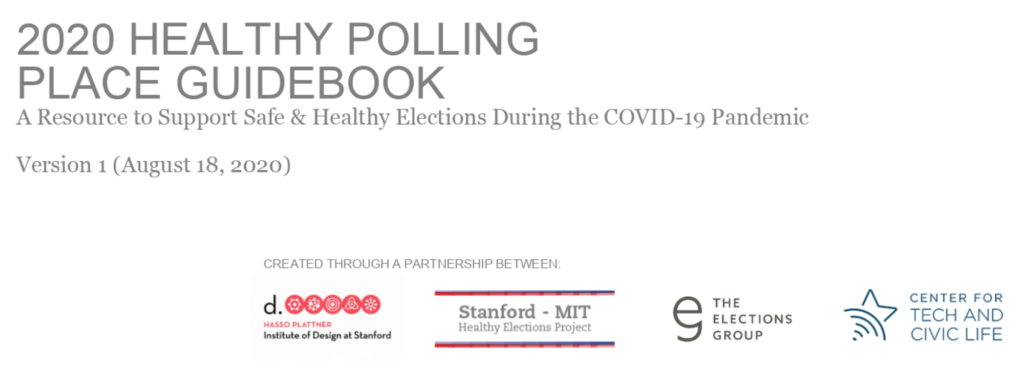Polling Stations, Supply Chains, and Ballot Verification – Solving for Election 2020
550,000 mail-in ballots were not counted during the primaries this year.
Why? Simple reasons: Voters mailed their ballots late, forgot to sign them, or used a signature that did not match the one on file with their local elections office. These inadvertent but crucial mistakes can swing close elections and may have an impact on November election results.
In-person voting has lower rejection rates but some voters are wary of voting in person at polling stations where cross traffic can heighten the risk of exposure to coronavirus. Absentee, or mail-in, ballots lower that risk substantially, and have led to a record 82.9 million absentee ballots requested and/or sent directly to voters by state elections offices. Yet, not every state offers voters easy access to absentee voting.
In response to significant variation in election administration rules across the states, a nonpartisan collaboration between Stanford Law School and Massachusetts Institute of Technology, the Stanford-MIT Healthy Elections Project, has built a clearinghouse of up-to-the-minute elections data. Project researchers are striving to educate voters on current election information and guide interested officials in hosting safe and effective elections.

The Healthy Elections initiative was initiated by renowned elections experts Professor Nathaniel Persily (Stanford) and Charles Stewart III (MIT) to ensure integrity, safety, and equal access in the 2020 election. The project provides extensive, non-partisan resources on everything election related: Vote-by-mail policy issues, battleground-state election updates, new voting-related technologies, and election supply chain problems, to name a few. In a New York Times op-ed, “With Six Weeks to the Election, Six Ways to Protect It,” the two elections scholars advised the public on simple steps to ensure the success of our elections: Make a plan for when and how you’ll vote; work the polls; mail your ballot early or, where possible, drop it off at an early voting site or secured ballot drop box; coordinate closely with your local elections office with any help you want to offer; and educate yourself by relying on your elections office for accurate information. They advocate caution, pointing out how misinformation about voting is proliferating. Accurate sources come directly from your state elections office. The Washington Post “How to Vote” state-by-state elections guide can lead you to that office and trusted information in your state.
The advice that Professors Persily and Stewart share for a healthy and effective election is grounded in the work of their Healthy Elections research team. The project is staffed by nearly 100 student researchers operating on teams led by graduate students and senior fellows with election law training. Tyler Bishop (SLS JD ‘20), is one such passionate team leader who sees the work of his team as contributing to “the most important election of our lifetime.”
Each project is coordinated by a law and/or graduate student and is supported by undergraduate and graduate student volunteers. Students come from different disciplines and are drawn to the project because they see the fragility of our democracy in a pandemic. As volunteer Grace Scullion (B.A. ‘22) describes, “After watching the chaos of the Wisconsin primary–long lines, closed polling places, and uncounted ballots–unfold on April 7th, I was deeply unsettled.” Over the summer, many volunteers were placed onto state-specific teams to rigorously follow local election-related legislation. They developed State Election Reports covering 19 states, including all battleground states. In Wisconsin, for example, Scullion worked on a report that describes “just how powerful courts are.” As in-person early voting rolls out in some states, research teams are now coordinating with community organizations to counter a shortage in poll workers due to COVID-19.
Project coordinators Chelsey Davidson (SLS JD ‘21) and Zahavah Levine (Stanford Distinguished Careers Institute Fellow) described their efforts to help election officials ensure a safe and democratic election this fall. Their research teams are helping elections offices across the states with information to support vote-by-mail operations and creating sanitary, socially distanced in-person voting spaces. One team focuses exclusively on signature verification and ballot processing, building on original research from a Law and Policy Lab report.
That report, Signature Verification and Mail-In Ballots: Guaranteeing Access while Preserving Integrity, was instrumental in the recommendations of a number of civil rights groups who encouraged the California Secretary of State to ensure uniform signature verification and ballot processing practices across California counties. The Secretary of State then responded with emergency regulations for the November 3, 2020, General Election. According to a Stanford Lawyer article, the new standards will make it “likely that fewer vote-by-mail ballots will be rejected for non-matching signatures this November.” The Healthy Elections Project is now tracking how such other states as New Jersey standardize signature verification processes. As the Healthy Elections team leaders agree, the challenges of ensuring a safe and democratic election are many, and it is the goal of the research teams to help county elections officials anticipate and overcome potential problems.
Vote-by-Mail Challenges
According to Professors Persily and Stewart, vote-by-mail is the best way to reduce person-to-person contact in the pandemic. But it is expensive and requires infrastructure and staffing that many states struggled to afford and implement before Election Day. Some counties face jurisdictional issues and, of course, there is the complicated process of mailing ballots to individual addresses and verifying ballot signatures when they return. Some states, too, are obligated by state law or policy to restrict elections to traditional in-person polling sites, making mass voting-by-mail operations legally impossible.
Yet, according to the Pew Research Center, mail-in ballots counted for 53% of ballots in the 2020 primaries, a massive increase from 27% in 2018 and 25% in 2016. With two weeks until Election Day, the New York Times absentee vote tracker shows that voters have already submitted 20.7 million mail-in ballots which is well on track to meet or surpass the 50.3 million absentee ballots cast in the 2020 primaries.
Supply Chain Challenges
With the expansion of vote-by-mail, Healthy Elections researchers point out that counties across the U.S. are seeking to procure many of the same items (such as envelope printers and sorting machines), leading to concerns about shortages and gaps in the supply chain.
For in-person polling stations, elections offices must plan ahead for adequate PPE, including masks and gloves and antibacterial cleaning agents. For absentee ballot operations, elections offices must ensure that they have operational technology to tabulate the ballots. A Healthy Elections report on Election Supply Chains (June 2020) recommended that election offices act early to procure needed supplies, as well as hire and train new staff. At the beginning of the summer, elections offices were unprepared to run extensive vote-by-mail operations, or integrate all the new safety protocols for in-person voting in a pandemic. Implementing all of these updates was “like asking them to do an entire second election,” remarked Tom Westphal (SLS JD ‘21). Yet elections offices are rising to the task.
Safe Polling Challenges
Since launching in March, the Healthy Elections Project has prioritized research on how to keep voters and poll workers safe. The lack of poll workers was particularly alarming to the research team who point out that 58% of traditional poll workers are above the age of 60 and, thus, at higher risk from the pandemic. Election experts anticipated a significant shortage of poll workers, and predicted that jurisdictions would have difficulty recruiting new poll workers willing to bear the health risks of staffing public polling stations. As seen in the 2020 primaries, a shortage of poll workers leads to long voter lines and frustration, resulting in overwhelmed poll workers and disempowered voters. The good news is that a nationwide effort to recruit healthy young people to serve as poll workers is making up the difference in many states. The Healthy Elections Project is now turning its attention to recruiting poll workers in selected regions, especially helping to recruit poll workers who have second language skills. To find out if your state still needs poll workers, visit the U.S. Election Assistance Commission or sign up through the Healthy Elections “Become a Poll Worker” site.
Avoiding Disenfranchisement
Researchers at Healthy Elections are concerned that changes in voting protocols may increase disparities that disproportionately affect Black, Latinx, and Indigenous voters. In-person polling is even more complicated for immunocompromised voters. Healthy Elections team leaders also highlight the importance of different language options for ballots as especially significant amid the conditions of the pandemic.
Healthy Polling Places Guidebook
As Bishop emphasizes, “The clock is ticking much faster for the election this year. We have one chance to get this right.”
Getting it right means that elections officials need reliable, nonpartisan information. The Healthy Elections Project met that need by collaborating with the Stanford Design School to produce a Healthy Polling Places Guidebook and poll worker training materials. The guide builds on hundreds of interviews with elections officials conducted over the summer and this fall in the Law and Policy Lab project, “Election Protection in a Time of Covid-19.” It assists election officials with practical examples for operating healthy polling sites and voting-by-mail operations during a global pandemic to help elections officials ensure safe environments for their workers, the voters, and any observers at polling sites.

Healthy Polling Place Guidebook, https://healthypolls.stanford.edu/resources/healthy-polling-places-guidebookSince publishing the guidebook at the end of August, the Healthy Elections team has also produced an array of “Tools for Designing Healthy Polling Places” (updated Oct. 14, 2020). Election officials will find tools to help them manage long lines of voters, surges in lines, and other optimization tools to help voters move through election sites more efficiently. The pandemic may not be the push election officials wanted to improve their methods but it appears to be the push that that will improve voting methods for elections to come.
